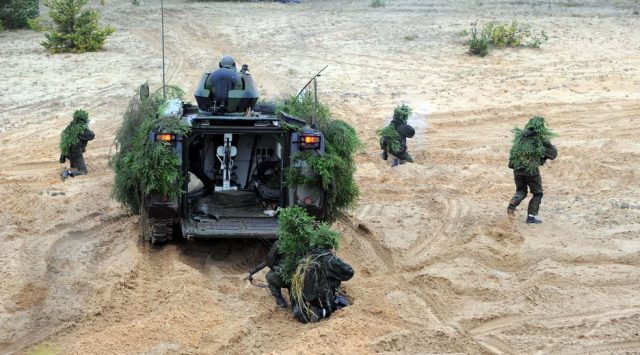
NATO’s New Force Posture in the Baltic Region: Pluses and Minuses (Part Two)
Publication: Eurasia Daily Monitor Volume: 13 Issue: 142
By:

*To read Part One, please click here.
It was a summit of modest expectations and modest results for the North Atlantic Treaty Organization (NATO) in Warsaw on July 8–9. These results are of an interim nature: building-blocks for further decisions at upcoming ministerial meetings, not waiting until the next summit. The Warsaw results do not, as yet, correlate with the growth in Russia’s capacity to threaten, intimidate, or subvert the Alliance generally and its eastern—now “frontline”—member countries in particular.
Any realistic defense against Russian conventional military aggression on the North Atlantic Alliance’s northeastern flank (the three Baltic States and Poland) could only begin with the deployment of the NATO Response Force (NRF) there. The NRF, however, is stationed far away from the Baltic region; and all military studies and war games on the public record have concluded that Russian forces could seize all or parts of the Baltic States’ territories before the NRF could possibly deploy there. Meanwhile, NATO’s four infantry battalions approved for rotational presence in that theater are suitable for dealing with “hybrid” incursions by Russian and proxy forces, or merely as “tripwires” in the event of conventional military aggression (see Part One, EDM, August 3).
NATO has recently tasked the “Headquarters Multinational Corps Northeast” (HMCN) with command and control on a full range of possible NATO missions in Poland, Estonia, Latvia and Lithuania. Those missions could range from exercises to Article V operations that would require deploying NATO Response Force elements to this region. This headquarters is actually based in Poland’s northwesternmost corner since 1999. (Its “Northeast” title may have fitted the situation in 1999, but became anachronistic since NATO enlarged much farther to the east.) Originally a tripartite German-Danish-Polish structure, the HMCN has in recent years been joined by officers seconded from all of NATO’s “new” member countries. The HMCN is a headquarters without troops to command in peacetime; but it would handle their deployment to this region in crisis or conflict situations.
The planned brigade headquarters in Poland, as approved at NATO’s summit, shall also be subordinated to the HMCN. This headquarters also executes command and control over the NATO Force Integration Units (NFIUs—see Part One) stationed in Poland, Estonia, Latvia and Lithuania. In 2015, HMCN’s readiness level was raised from a lower-readiness forces headquarters to high-readiness force headquarters, specifically to oversee NRF deployments to this region. The HMCN was certified to have attained operational capacity on the eve of NATO’s Warsaw Summit (MNCNE.pl, accessed July 30).
NATO’s Warsaw Summit reaffirmed the 2014 Wales Summit’s decisions on the NATO Response Force and approved the NRF’s further development. Those troops remain generally home-based (excepting US troops based in Europe) and would convene for joint exercises or missions, including crisis and conflict contingencies. A total of 40,000 troops from most NATO member countries are earmarked for participation in the NRF. Of that number, 5,000 troops are planned for the Very High Readiness Joint Task Force (VJTF), the “spearhead” to the overall NRF’s “shaft.” The VJTF itself is planned to include one highest-readiness battalion of 650 troops.
On current planning assumptions, the VJTF would be the first NRF element to be deployed to a conflict theater, ahead of two follow-on brigades, in turn to be followed by the NRF pool. All these forces are planned to be multinational in their composition. The 5,000-strong, basically infantry VJTF is planned to include maritime, air, and special-force components. The two follow-on brigades are planned to additionally include anti-Chemical-Biological-Radiological-Nuclear protection units. The NRF’s readiness to deploy varies from 48 or 72 hours for the highest-readiness battalion, to 5 or 7 days for the VJTF, to 30 days for the first follow-on brigade, 45 days for the second follow-on brigade, and longer for the NRF pool.
Those schedules, however, seem inadequate for conflict scenarios in the Baltic States. There, local forces and rotational allied forces lack strategic and operational depth that would, elsewhere, allow defending forces to trade space for time. Moreover, NRF reinforcements in a crisis would have to run the gauntlet of Russian anti-access/area-denial (A2/AD) capabilities deployed in the Kaliningrad region. Nor can NATO entirely count on the guaranteed use of Sweden’s and Finland’s air and maritime spaces in order to bring reinforcements to Estonia, Latvia or Lithuania.
Ultimately, the NRF is not dedicated to the Baltic theater. NRF elements are to be deployed for action in any theater as may be required at any given time. In such cases, Russia could counter through “horizontal escalation” by creating crisis in the Baltic region while the NRF (modest in size to begin with) is deployed elsewhere.
This situation confirms that there is no substitute for credible deterrence and defense in-theater in the three Baltic States and Poland. Solutions approved at the NATO summit just held should be regarded as stop-gap measures, interim steps that can lead to more realistic solutions at upcoming high-level meetings of the Alliance.




